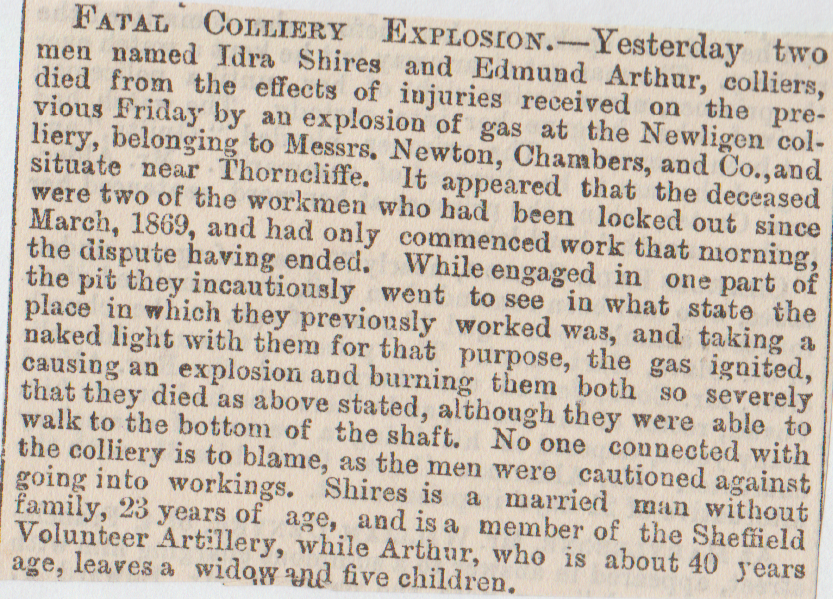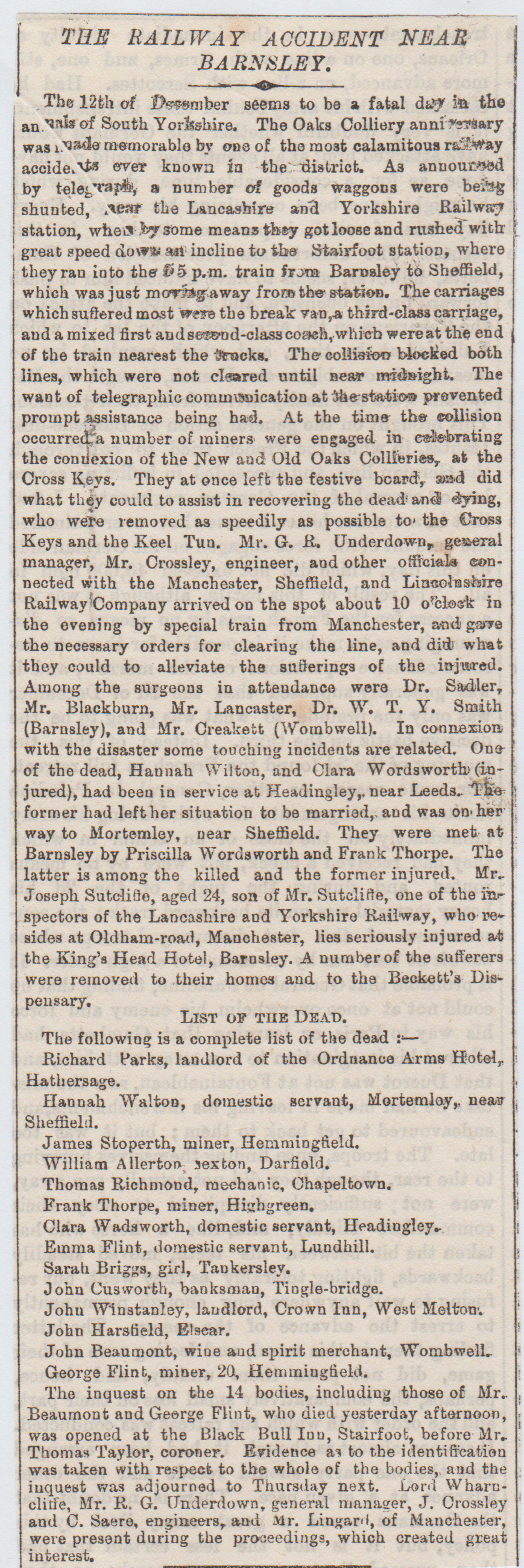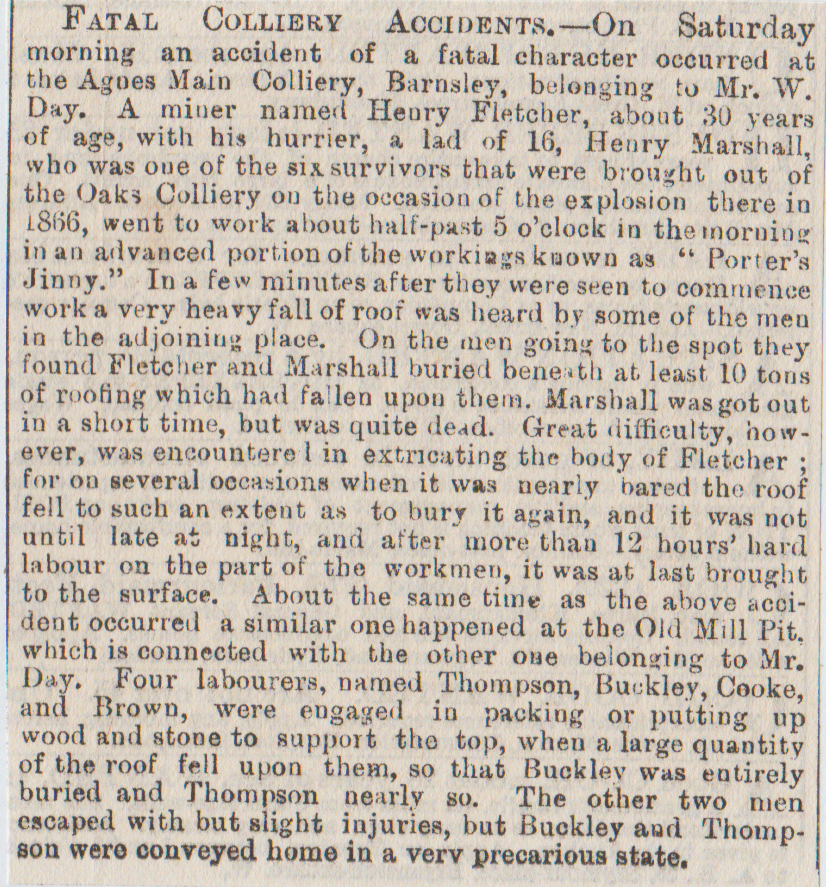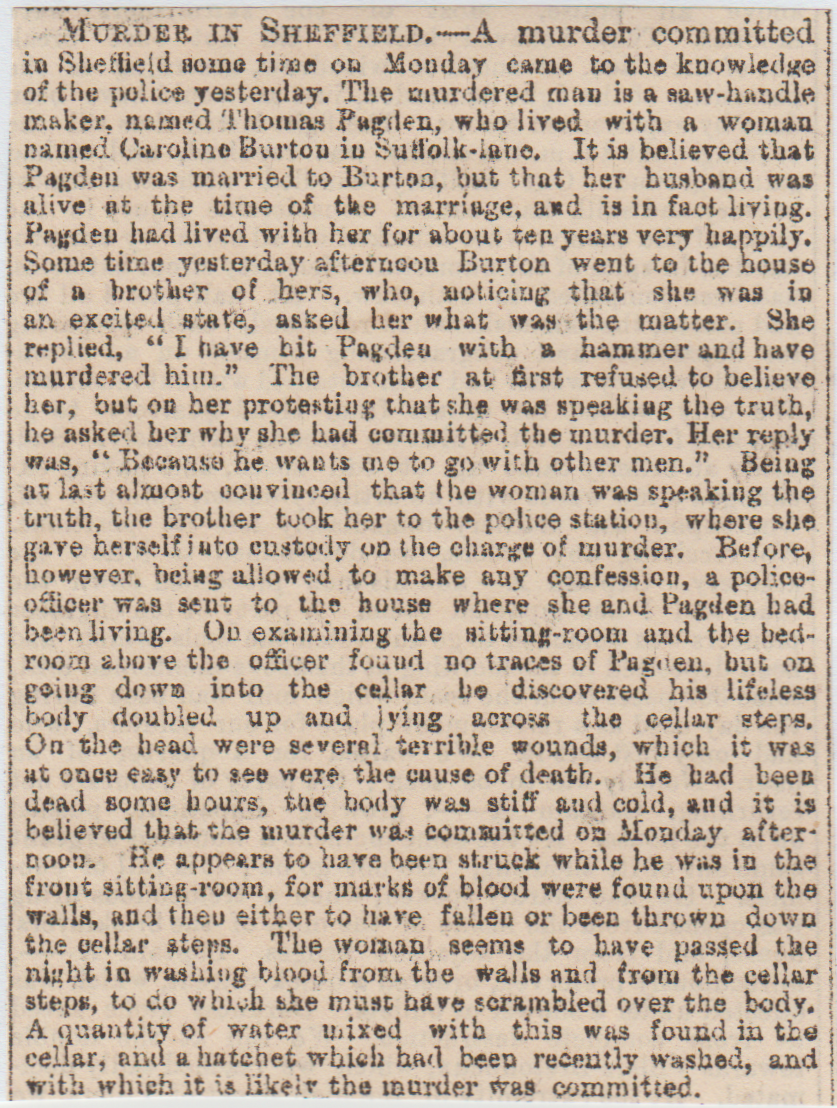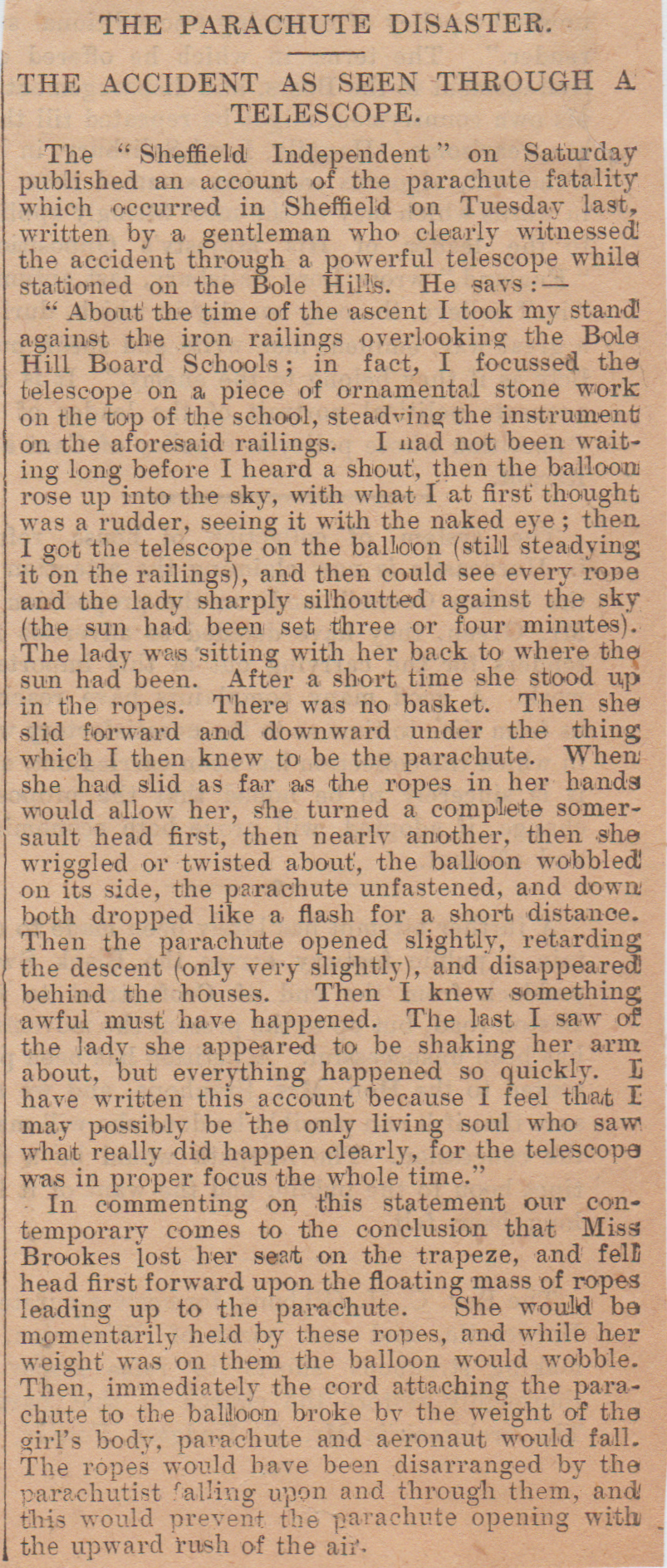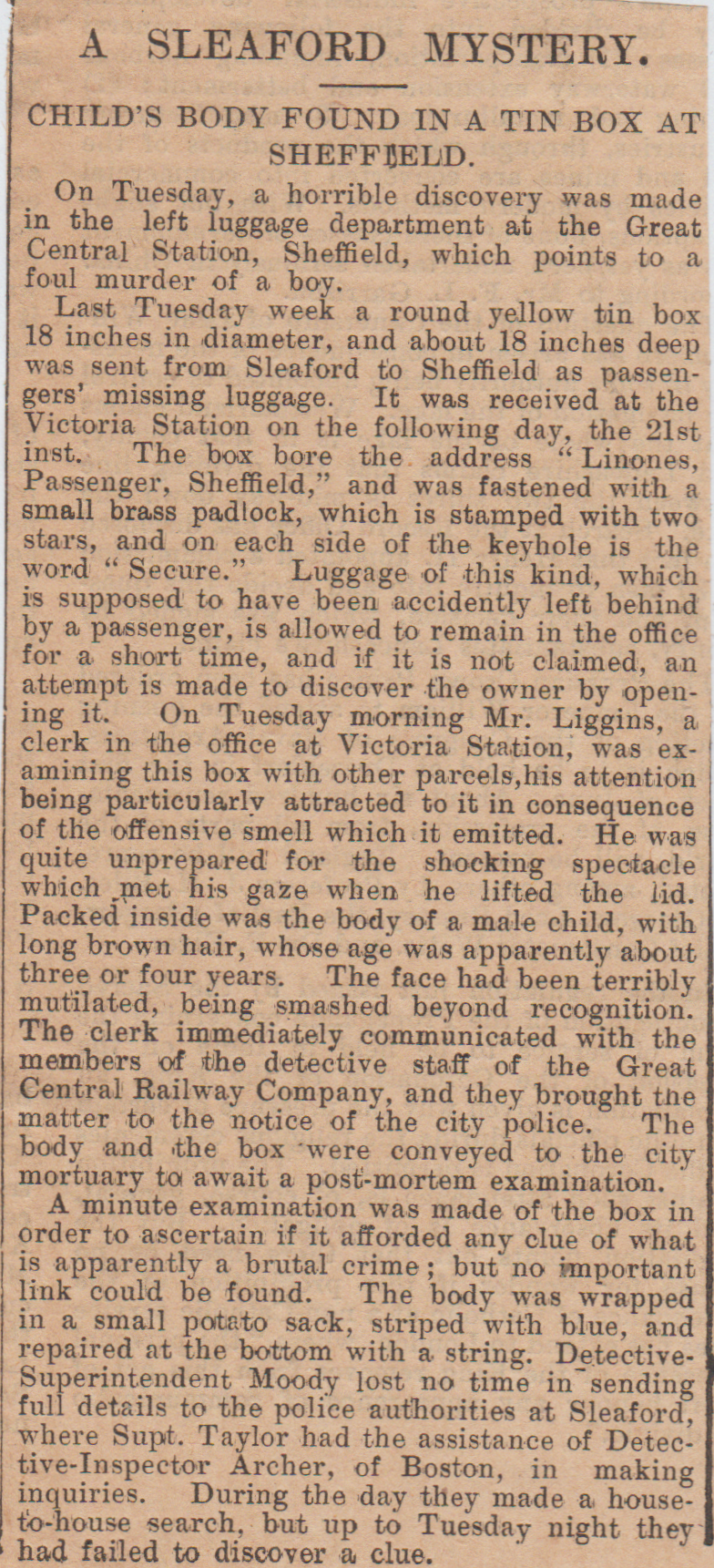1/ Oaks Colliery Disaster, Barnsley, December 1866
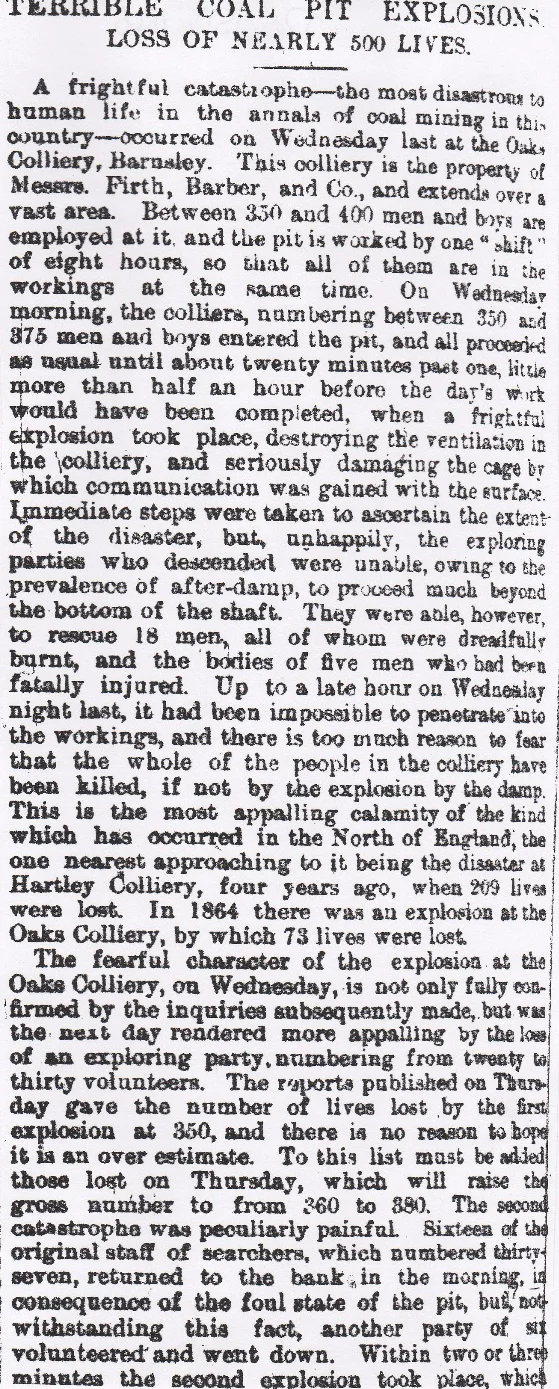
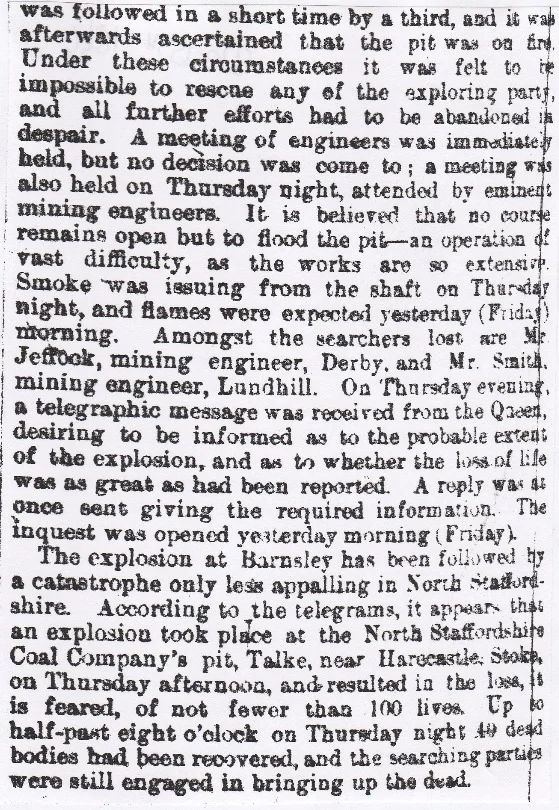
2/ Masborough near Rotherham, (Hotel Death) December 1916
At the Queen’s Hotel, Masborough near Rotherham, Mrs Laura Athey, the landlord’s married daughter was found dead, sprawled across the fireplace in her bedroom. (Is it still there?)
3/ Victoria Station, Sheffield, (Child Remains) August 1876
The mutilated remains of a ten-month-old child were discovered in one of the waiting rooms at Victoria Station in Sheffield. The limbs had been severed from the body and are missing. It was wrapped in a shawl and was very decomposed.
4/ South Yorkshire Asylum Manslaughter, Wadsley, October 1885
An inquest was held at the South Yorkshire Asylum, Wadsley, on the body of John Manley, a lunatic who was found dead in bed with his head pressed between the wall and the bedstead. The post-mortem revealed that he died from strangulation. Another inmate was witness to what happened and he stated that another inmate named Brookes rose from his bed in the night and strangled Manley. The coroner said that the law held Brookes to be irresponsible and a verdict of manslaughter could not be returned against him. The jury found the evidence was insufficient to show how death was caused.
5/ Barnsley Murder, July 1887
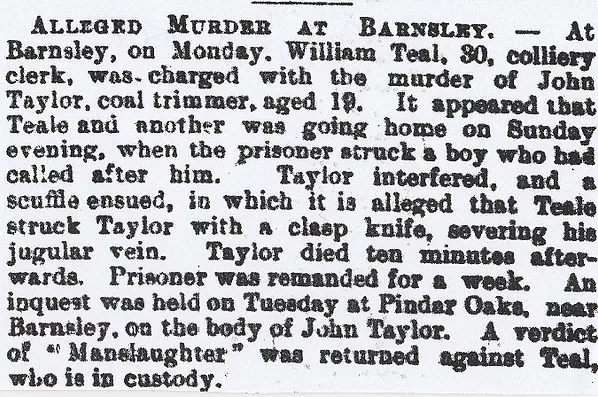
6/ Sheffield Steel Factory Explosion, September 1887
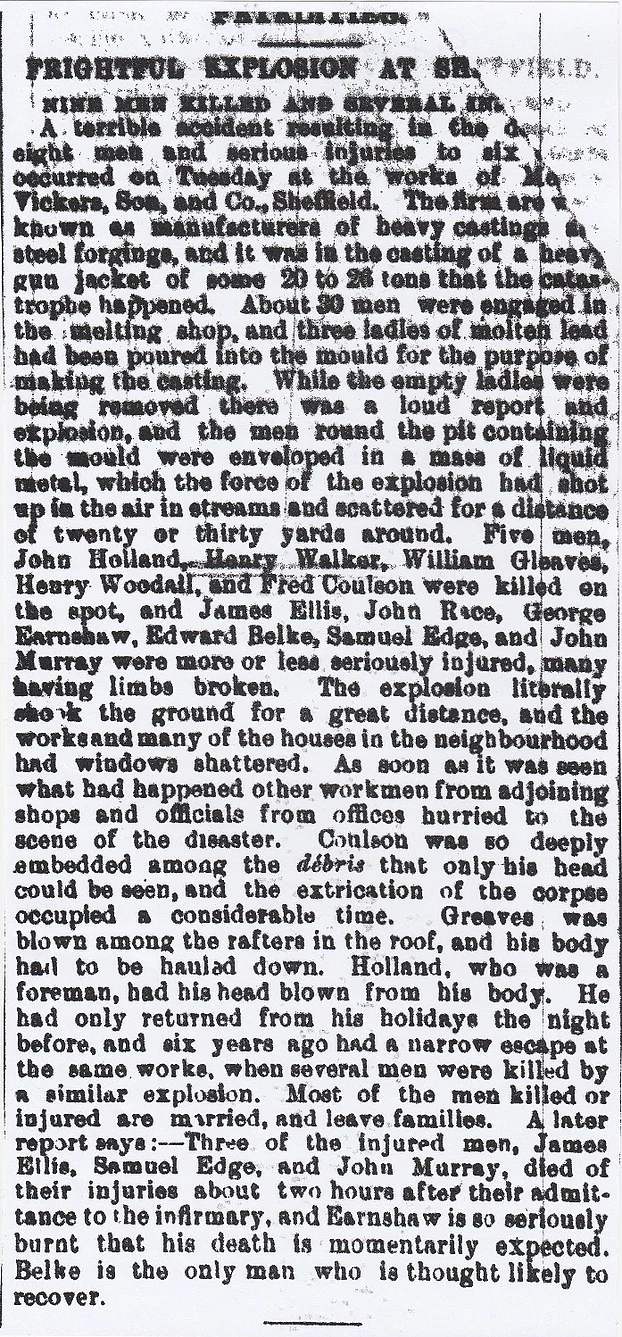
7/ Monk Bretton Murder, near Barnsley, April 3rd, 1899
Yesterday forenoon the body of a widow named Mary Ann Whitehead aged fifty-eight, of Barnsley, was found in a disused quarry at Monk Bretton near Barnsley under circumstance which points to murder. The woman was last seen at nine p.m. on Saturday, being then intoxicated. There are marks on her throat suggesting strangulation and her purse and money have been taken. Her hat was found several yards from the body.
April 4th, 1899
At Barnsley yesterday Richard Thomas Wormald, glass hand of Monk Bretton was remanded on a charge of wilfully murdering Ann Whitehead, widow, of Barnsley. It is alleged that the parties were seen together on Saturday night and the woman was found dead on Sunday morning, having been strangled and robbed.
April 11th 1899
Yesterday at Barnsley, a glassblower named Richard Thomas Wormald was committed for trial on a charge of murdering a widow named Whitehead aged sixty-two on Saturday the 1st at Monk Bretton, a colliery village near Barnsley. it was stated for the prosecution that Mrs Whitehead and Wormald were seen to leave a pub at Monk Bretton and walk together in the direction of a disused quarry where on the following morning the woman’s body was found, having been found strangled and robbed. The accused protested his innocence saying he left the house after the woman and went for a walk in the village.
8/ Holbrooke Colliery, Killamarsh, March 1885 (Any deaths?)
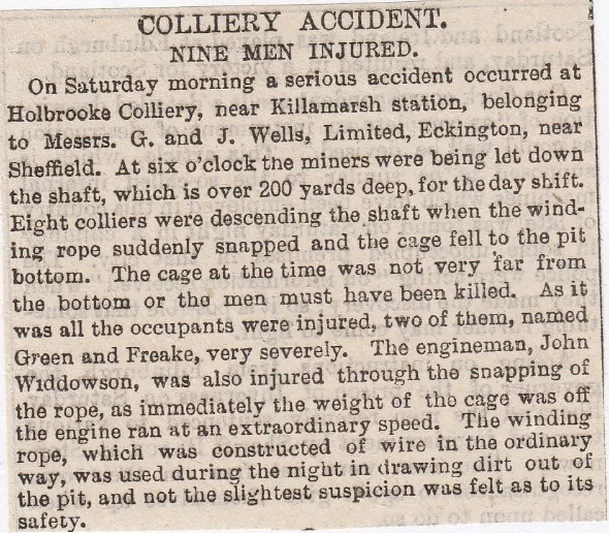
9/ Sheffield Suicide, December 1851
This is the story of a suicide of a young girl in Sheffield who was charged with pinching an accordion from a playmate, which she denied ever happened. Her parents told her off and read her the riot-act, so she walked into the garden and committed suicide by drowning herself in a well.
10/ Greaseborough near Rotherham, (Air-Raid Suicide) May 1919
An engine driver named Richard Seddons from Greaseborough near Rotherham had been suffering from a nervous breakdown which was caused by worrying about the German air-raids over Yorkshire towns and cities, was discovered drowned in a dam. Apparently, he had threatened to do himself in before, so the verdict of “Suicide during Temporary insanity” was returned.
11/ Wincobank Station Fatalities, March 1885

12/ Mexborough, (Triple Murder/Suicide) November 1904
Here’s a man with a great Northern name of Walter Trubshaw. He was a 35-year-old commercial traveller who resided at Mexborough and battered his wife and two kids to death with a policeman’s truncheon and then slit his own throat with a razor. Trubshaw died on the spot, but the other victims clung on to life for a while and then died from their injuries. Ethel Hill, a fifteen-year-old servant heard screaming and shouting and her mistress yelling “Ethel, come quick!”. She found Trubshaw beating his missus with a truncheon, then when he spotted Hill, he went for her. She managed to evade him but also heard the four and two-year-olds crying out “Oh, Dada!”. Hill managed to raise the alarm with Mr Ellis, a neighbour. What brought this on is a complete mystery as he absolutely adored his wife and children, but it is thought he had become insane.
13/ Doncaster Racecourse, (Death from Excitement) October 1875
On Monday afternoon at the Grimsby and Cleethorpes race just before the final event was announced to take place, the treasurer to the race fund, Mr John Hailstone, fell down in what was supposed to be a fit and died almost immediately. Disease of the heart is said to be the cause of death. Deceased had just won, having backed the first horse- Murino, in the race for the Member’s Plate. He was about forty-years-old, married and leaves a widow and family. It is thought that his untimely death was produced by excitement. The last race for the Scurry Stakes, was not, of course, run.
14/ Sandall Drownings, near Doncaster, December 1900
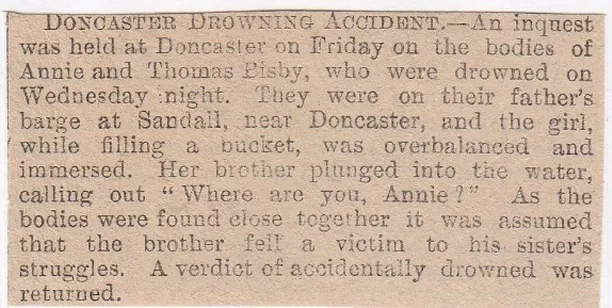
15/ Kiveton Park Railway Fatality, Rotherham, December 1876
On Monday morning the mutilated remains of a man were found lying on the main line of the Manchester, Sheffield and Lincolnshire Railway, near Kiveton Park. The arms and legs are completely cut off and the body shockingly disfigured. The remains are believed to be those of a miner named George Brown of Shireoaks, who must have been trespassing on the line at the time he was killed.
16/ Sheffield, December 1860
A man named Wilcock was staying at Sheffield in order to prosecute a man for robbery, but word came back that he was going to produce witnesses to show that he visited brothels and hung around with the criminal fraternity. This preyed on his mind so much, that he decided to commit suicide rather than stand up at the trial and endure the questioning.
17/ Wombwell Station Fatality, February 1899
A fatal accident occurred yesterday at Wombwell main station on the new Midland line from Sheffield to Barnsley. The unfortunate man was Arthur Gray aged twenty-one-years, single and a porter employed at the station. At the time of the accident, he was assisting in shunting operations near the station when he was knocked down and killed.
18/ Cadeby Colliery Explosion, near Doncaster, March 1899
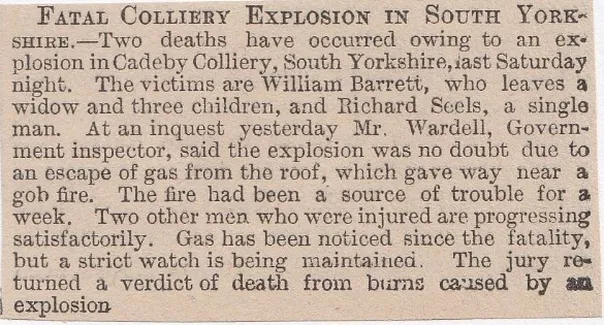
19/ Pogmoor Child Murder, near Barnsley, September 1894
John Smith was committed for trial at Barnsley, charged with murdering his two-year-old daughter in the village of Pogmoor near Barnsley, (now part of the town). He got a shoemaker’s knife and cut her throat.
20/ Agnes Road School Death, Barnsley, October 1896
On Wednesday morning a shocking accident occurred at Agnes Road Board School in Barnsley, resulting in the death of a boy, named James Norton aged five and serious injuries to four other children. They were at play in the playground, when a stack of floorboards required in the alteration of the schools, fell forward and buried them. Norton was fatally injured and four other children were crushed, one having an ankle broken.
21/ St Matthew’s Church, Sheffield, July 1891 (Steeplejack Killed)
A steeple-jack named Edward Gilbert was doing some decorating work on the weather-cock, atop St Matthew’s Church spire in Sheffield, when the vane to which he was fastened broke off and he fell headlong into the street. The distance he fell was about one hundred and twenty feet. The injuries were too severe for him to survive as his head was totally smashed in.
22/ Sheffield, (Awful Factory Death) June 1888
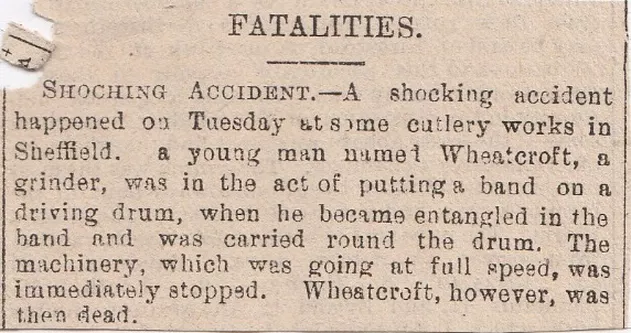
23/ Manvers Main Colliery, (Fatal Accident) December 1872
On Saturday a miner named Benjamin Humphries, living at Swinton and working at Manvers Main Colliery, was killed whilst following his employment. It appears he was engaged removing “props” in his working place when one of the pieces of timber unexpectedly left the coal and struck him so violently on the body as to cause instantaneous death. Deceased was married and has left a widow and several children.
24/ Cudworth South Junction, (Tragic Fatality) May 1885
At Cudworth South Junction on the Midland Railway near Barnsley, a labourer named John Godfrey, who had only just entered the service of the Company, was employed with other men emptying ballast waggons. During a shower, Godfrey sheltered under a waggon and on coming out, unfortunately, stepped in front of the down Scotch mail and was literally cut to pieces.
25/ Totley Tunnel Bodies, near Sheffield, September 1898
The mutilated corpses of two Midland Railway workmen named Partridge and Graham were discovered in the Totley Tunnel near Sheffield. They were meant to pick up wages last night but never arrived and when they searched the place where they were working, the bodies were found. They were cut to shreds and barely recognisable, only the clothing gave a clue as to their identity. They were both married and one was also a newsagent as well as having the railway job.
26/ Parkgate, Rotherham, May 1900

27/ Dalton Brook/Thrybergh near Rotherham, (Murder Confession) May 1882
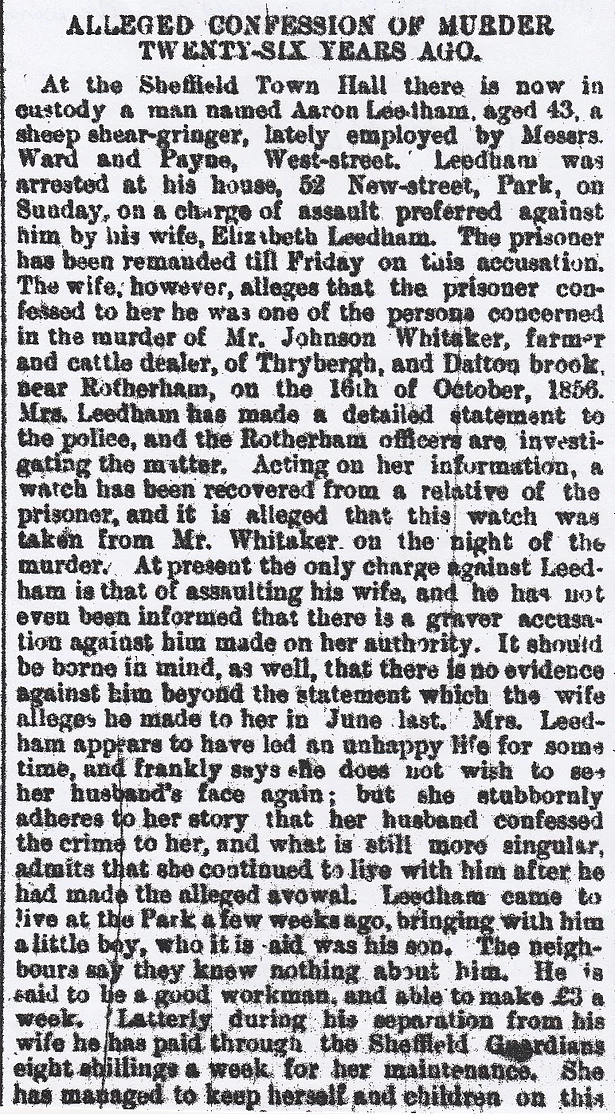
pittance, eked out by her earnings as a charwoman.
28/ Hoyle Mill Murder/Suicide, Barnsley, April 1910
A shocking double tragedy took place in Hoyle Mill, a suburb of Barnsley, when around 2-30 p.m. a policeman was told about the death of a man, thought to be from Halifax. He went to the body and concluded that he had poisoned himself. Another person living in the locality told police that the deceased had told him that he’d murdered his girlfriend, so police straight away began to search the area and question neighbours. Nearby, the body of a woman lay in an outhouse and all indications suggest that she too was poisoned. A letter was found on the bloke and from reading the contents it would seem that she was working as a domestic servant somewhere in the district. (What were the names?)
29/ Micklebring Suicide, near Conisborough, November 1860
A farmer from Micklebring near Conisborough, named Wood, killed himself one morning. He was a tenant of Mr Nicholson and last week the deceased had paid him six months rent in one payment. In the wad of cash was a £5 note which was a fake, so Nicholson sent a servant with the fiver to inform Mr Wood that his money wasn’t kosher. When questioned about the note Wood said he received it from a gentleman in Doncaster on market day. Since being told of this, he really became despondent and told his missus that he was going to do himself in, as he’d been ripped off and lost quite a bit of money in the process. The wife passed them off as idle threats, but she found him hanging in an outhouse soon after. The news reached Doncaster market and the bloke who passed it on to Wood said that he got it from a group of villains in the area, who are using counterfeit money and possibly printing it themselves.
30/ Grimesthorpe Road Murder, Sheffield, August 4th, 1885
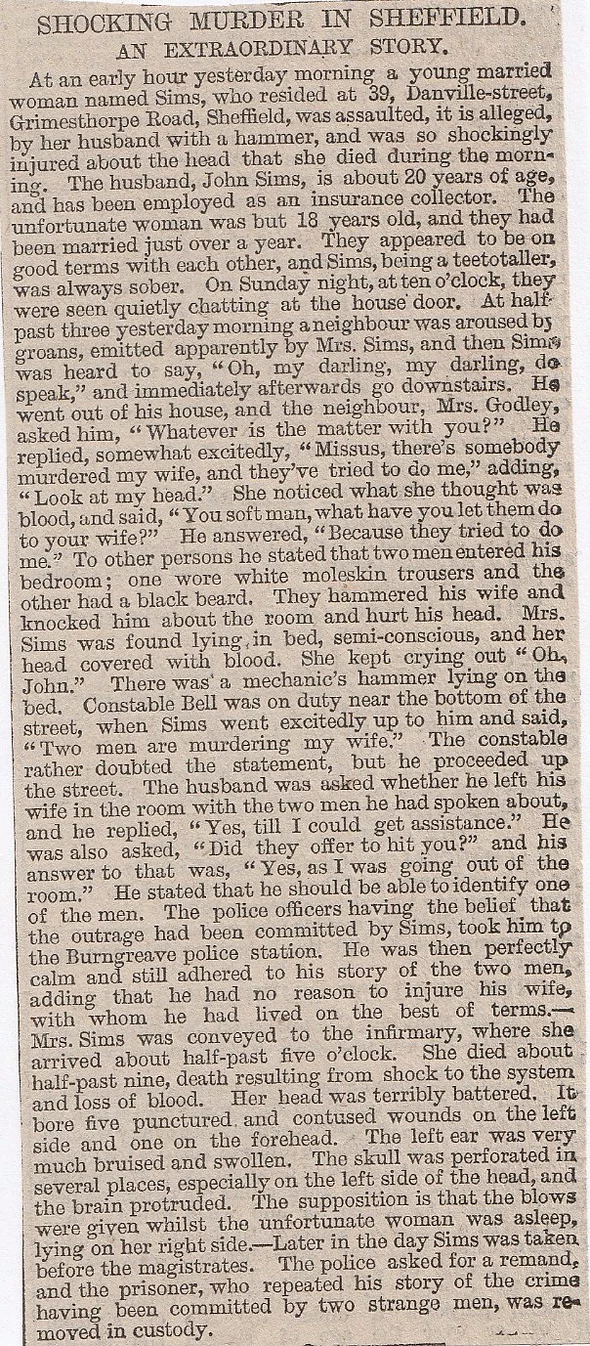
Grimesthorpe Road, Sheffield, (Death Sentence) November 27th, 1885
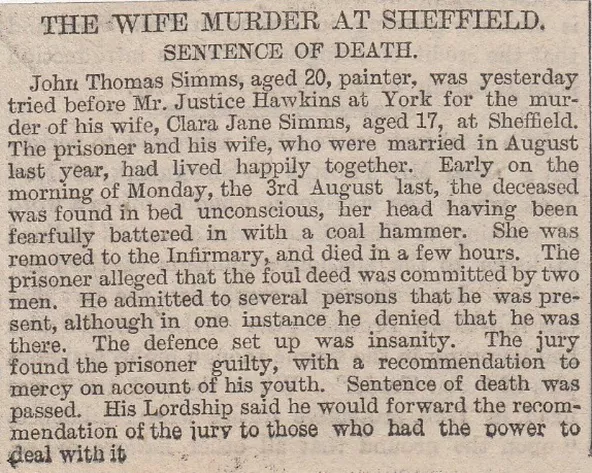
31/ Devil’s Elbow Servant Suicide, Doncaster, February 1873
At two p.m. one Saturday afternoon, a teenage girl was spotted plunging into the river (Don?) at Devil’s Elbow near Doncaster. A boatman rescued her straight away and she was taken to the New River Tavern, where she died shortly after the rescue. The young girl was fourteen-year-old Sarah Ann Stocks, who was a domestic servant for a Mrs Law, getting a shilling a week pay. Recently though, some bits and bobs had gone missing and Mrs Law thought that Sarah had been pilfering from her, so she didn’t give her the usual shilling wages. Sarah was so frightened of her father’s reaction that she decided that suicide was a better option. She left her mistress’s house and went directly to the river and dived in.
32/ Rotherham Murder, May 1880
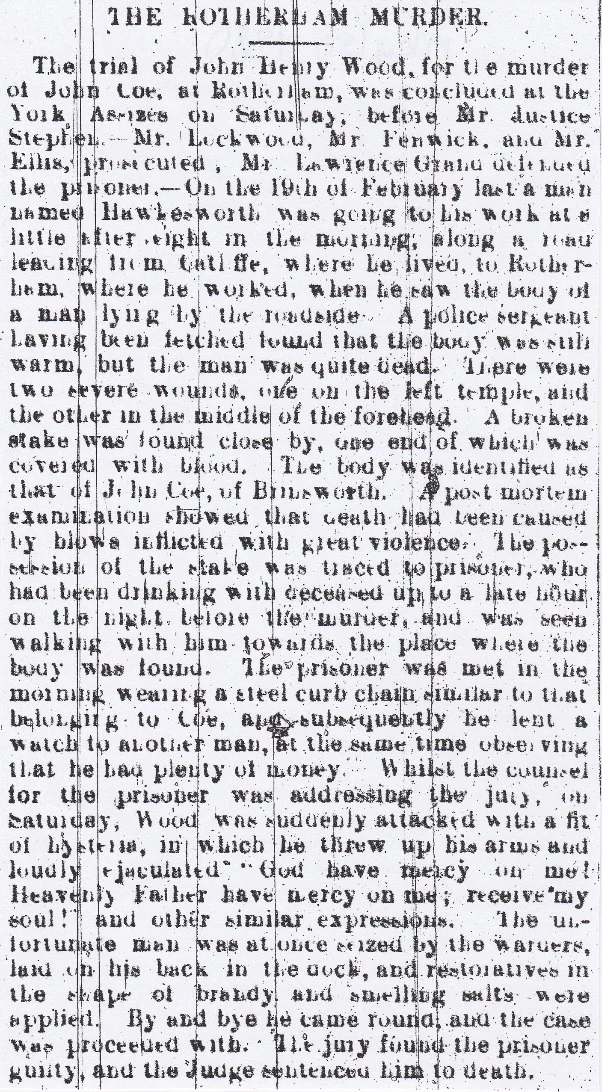
33/ Forge Yard, Wadley Bridge, (Hideous Death) August 1859 (What a way to go!)
William Pickering lived at Forge Yard in Wadley Bridge near Sheffield. He was messing about next to a pond adjoining which is a water-wheel and while walking on a plank, overbalanced and fell in. The wheel was going around at the time and it sucked him into the current. He was lifted by a bucket and precipitated the other side. A lad who was with Pickering started shouting for help and when the poor boy was fished out of the water, his head had been wrenched off. He was also missing his left leg.
34/ Worsborough Bridge Ice Fatality, Barnsley, December 1885
A fatal ice accident occurred at Worsborough Bridge, to a schoolgirl named Sarah Ann Hammond whose parents reside in that hamlet. The deceased and a number of other girls left the Wesleyan day school, Worsborough Bridge, at noon. Instead of going home they went to the canal which is near the school and the water of which was frozen. The girl went on the ice and she fell in and was drowned. Several others were about to get on the ice when it gave way.
35/ Moor End (Fatal Accident), near Thorne, February 1865
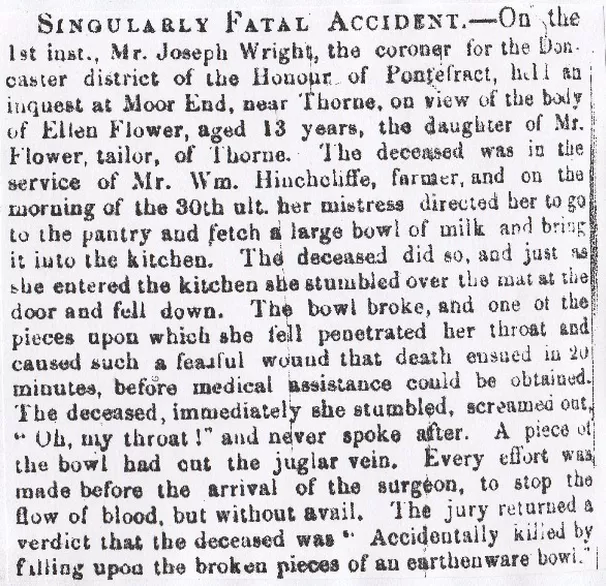
36/ Sheffield, June 1891 (Suicide in Labour)
Clara Steer, whilst in labour, committed suicide by slitting her throat, stabbing herself half a dozen times in the left breast and then attempted to tear open her abdomen. Her neighbours were helping her through the labour and both had left the room for a minute when they heard noises, when on entering the bedroom they found her bleeding profusely lying on the floor. Steer died within a few minutes, and I presume the child died as well.
37/ Rotherham Barber’s Suicide, August 1878
A Rotherham barber named Burton who committed suicide by hanging himself was known throughout the district as an eccentric character-or nutter as we’d call them today. He tried to hang himself before the successful effort but the strap he tried to do it with snapped. Then in chalk on the floor, he’d written “The strap broke”- as though apologising for his first-time failure. He then wrote the following lines for his wife: “August 10th, six a.m.- Dear Wife, Bless you. This is my last wish; The snuffbox must go to the dram-shop, where I have spent many happy hours. My body for cremation; or Barton make the box, but no parson- Robert Burton. Goodbye, I am tired of living, for I am a torment to myself, and everyone else- R.B.”
38/ Sheffield, (Boy and Girl Mutilated) July 1880
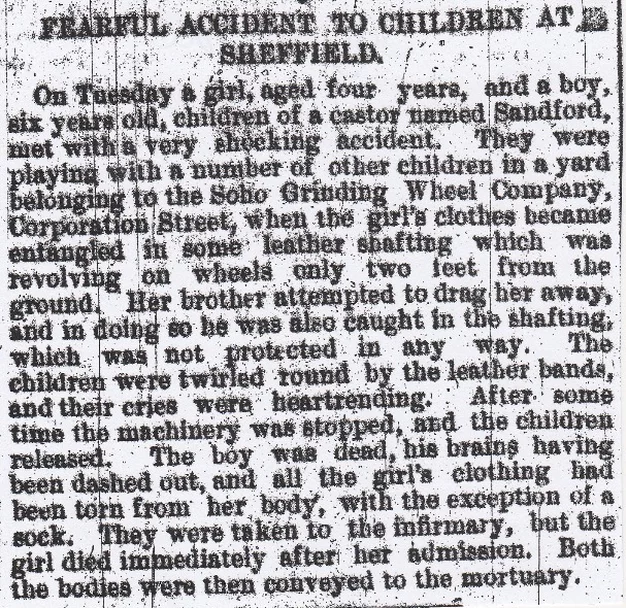
39/ Sheffield Infanticide/Suicide, April 1880
In the canal which runs through Sheffield, a woman’s body and a child’s also, where found near the same spot. The woman has been identified as that of Lucy Oldfield, domestic servant and it is believed that the child is hers. Oldfield had been unemployed for some time and belief is that she killed herself and the baby out of want. A man’s corpse was also found near the woman’s and it thought that he was trying to save her life he drowned also. As yet he is unidentified.
40/ Barnsley Suicide, July 1865
A tradesman who was smoking his pipe at a neighbours house at midnight, said to the fourteen-year-old daughter, that if she popped next door with him he’d give her some roast pork (not a euphemism) for her Dad’s supper. She went with him, but when she hadn’t come back soon after, so the father went round and saw “something improper going on”. She was bawling her eyes out when she returned and screamed out that “he was a bad ‘un”, so she ran out and jumped into the nearby reservoir. She was dragged out but then straight away tried to drown herself again. Again she was rescued but she managed to poison herself with an ounce of corrosive sublimate at the same time.
41/ Sheffield, May 1888
The boys named William Plant aged seventeen and Charles Wood aged fifteen were playing at Sheffield on Wednesday, when the former presented a revolver which went off and the bullet entered Wood’s brain, causing instant death.
42/ Stannington Boiler Explosion, near Sheffield, December 1885
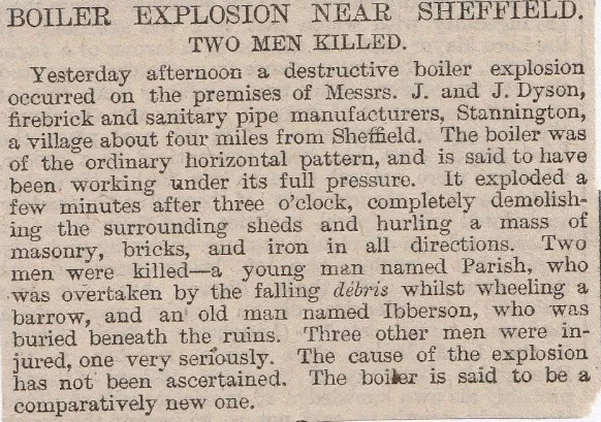
43/ Swallownest, Rotherham, September 1915 (One bullet, two lives)
A mystery of a woman’s death at Swallownest near Rotherham was eventually solved. Mrs Lucy Martin, a collier’s wife and mother of seven kids, was hanging the clothes out to dry in the garden behind her house. All of a sudden a gunshot rang out and she fell down dead from a bullet in the head. A car was passing the scene at the exact time and the neighbours immediately suspected the driver of being involved in some way. The number of the car was taken down and the driver was questioned about the shooting. He denied any knowledge but said he heard the shot of a gun as he drove past. Police then deduced it came from a house overlooking Mrs Martins backyard and they found the body of an old miner, John Johnson with a gun by his side. In a million to one shot, literally, he committed suicide due to lack of work and the bullet passed through himself and into Mrs Martin’s temple.
44/ Black Swan Inn Suicide, Fargate, Sheffield, May 1870
This one holds a special place for me because I suffer from grand mal seizures as well and it proves how far we’ve come in helping to cure epilepsy and the depression so often associated with the condition. That’s my little piece over. This concerns Theresa Davy, daughter of John Davy of the Black Swan Inn, Fargate. She was a gorgeous eighteen-year-old, with one drawback in life- her epileptic seizures. She helped out at the pub occasionally, but the seizures had started to make her somewhat depressed. One Saturday night at eleven p.m., she swallowed a load of vermin killer and ended it there and then. (Is pub still there?)
45/ River Sheaf Drowning, Sheffield, June 1885
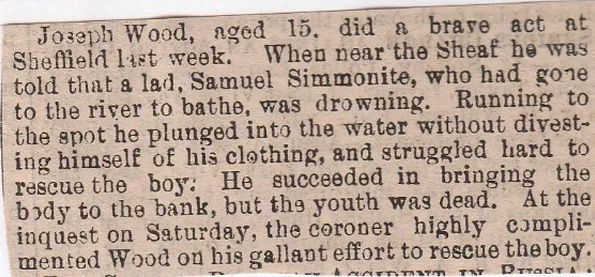
46/ Strawberry Island Drowning, River Don, Doncaster, February 1895
On Sunday afternoon a young man named Holland, who lived at Mill Street, Marsh Gate in Doncaster, was drowned in the river at Strawberry Island. The ice at that part has been dangerous for some days and several narrow escapes have taken place.
47/ Stainbrough, (Dead Infant Found) August 1884
Three lads were roaming the area between Locke Park and Stainbrough, when they came to the stream where they were going to bathe. They thought they saw the corpse of a dead dog in the stream, but on closer examination, it proved to be a child with a bit of cloth over its face. It was taken to the Strafford Arms Hotel and found to be a little girl dressed in a night-dress, who was only about a month old.
November 1884
A domestic servant named Ann Parkin was convicted of the murder of her illegitimate five-week-old daughter at Stainbrough. The mother had fractured the skull, then she dumped her in the stream.
48/ St Barnabas Road, Sheffield, December 1885 (Attempted Wife Murder/Suicide)
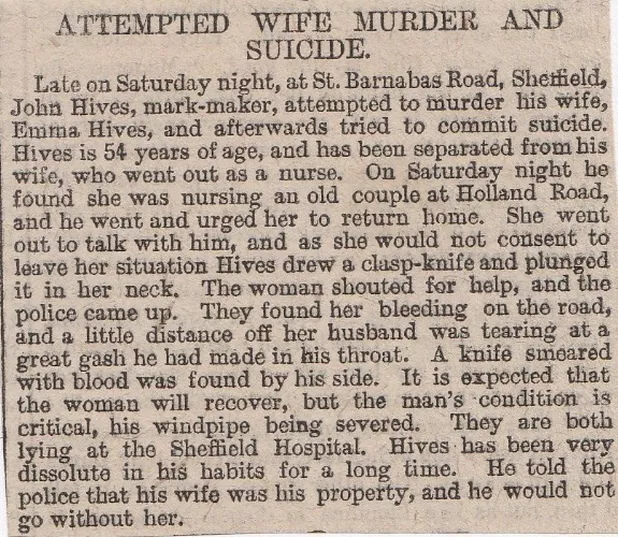
49/ Dockin Hill Drowning, Doncaster, July 1882
At Doncaster on Monday, an inquest was held respecting the death of Joseph Alfred Martin aged nine, living with his step-father at Gas Row, who fell overboard on Saturday afternoon. The young chap and a couple of others were playing on a barge lying at Dockin Hill when he accidentally fell in and drowned. The body was searched for but not found until Sunday morning. Verdict of “Found Drowned” was returned.
50/ Worsborough Colliery Tragedy, near Barnsley, November 1907
Seven men were killed in a tragic accident at the Barrow Hematite Company’s colliery at Worsborough when the men were precipitated down a shaft, about eighty yards down. It was at No. 3 shaft, which they use for the Parkgate, Thorncliffe and Silkstone seams. Sixteen men climbed in at the Parkgate seam, which is closest to the surface and just as it was being lowered to Thorncliffe seam something went badly wrong, when the foot-plate that the men usually walk out into the pit was not lifted up before the cage was started, then the engine began to wind up the cage, it tilted over and men fell out down the shaft. The names of the dead men are -Walter Goodchild, Thomas Cope, Ben Rooke, Tom Jennings, William Black, Isaac Farren and Frank Ackroyd. There are also three others who are in a critical condition: Charles Wigglesworth from Barnsley, George Hoddle from Worsborodale and Herbert Sanderson from Worsborodale. One of the dead, Isaac Farren, was having his 21st birthday the day he died and his Mum was organizing a party for him when she got word of the tragedy.
51/ Dunlop Street, Attercliffe Common, (Two Suffocated) September 1885

52/ Glossop Road Suicide, Sheffield, March 1884
The professor of languages, Carl Wehnert, left home in Glossop Road in Sheffield and made his way to the Church Institute on St James’s Street, to go and give some lessons. He was old by today’s standards, let alone Victorian ages, at nearly eighty. He went to a shop on Convent Walk and was never seen alive again. There was talk in the area of him being murdered but when some lads who were playing at the Endcliffe Dam saw what they believed to be a dead animal, they threw stones at it. Another bloke coming up saw it was a man’s body. When the pockets were checked they had been fastened together with safety pins and his watch and money were in them. This makes police think that he committed suicide by drowning himself, but he was in good health and was well off, so why he killed himself is a mystery.
53/ Cheswick Street, Walkley, (Child Remains Found) March 1891
Jane Hague lives at No 41, Cheswick Street, Walkley, and when near to her home on a piece of waste ground, she discovered the decomposed remains of a baby. P.C. Taylor lives nearby and was summoned to the scene. He found a straw-covered hole, also missing from the child were the left foot and the right hand. Police think that the child was buried in the hole and a fox or some other creature has dug it up and gnawed on the limbs. The infant was severely decomposed anyway, so it had been there for quite a length of time.
54/ Worsborough Bridge, (Sad Death) March 1892
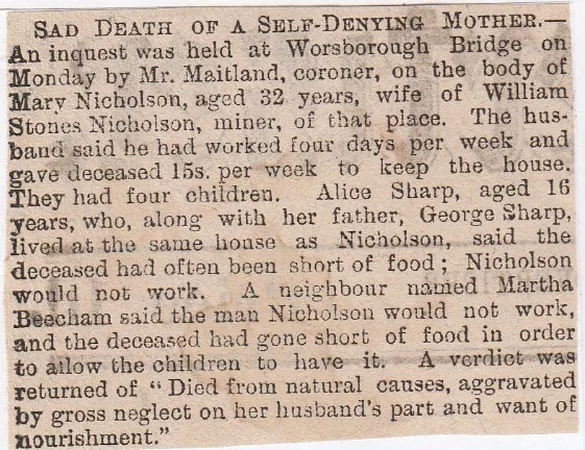
55/ Sheffield, September 1857 (Brothers Suicides)
Two of the sons of John Adams, a furniture dealer from Devonshire Street in Sheffield, have committed suicide in the following manner. Henry was only fifteen and the youngest and his father told him off about something, then boxed him around the ears and said in a deep Yorkshire accent “get out of the shop wit thee”. Henry took it to heart and went to his sister’s and told her “Tell my father I shall never come home again”. He lived up to his word and was found in the canal near Blast Lane on Monday morning. The other brother, William, was slightly older at twenty-one-years of age, but was a weedy chap and was unable to work. The day after Henry’s disappearance the father sent William on an errand to pay a bill. William never came back, instead, the father got a letter in the post, written in William’s handwriting, and saying:
“Money is of no use to me. You will never see me alive again. I have paid this”- William’s body was discovered in Attercliffe, having drowned himself.
56/ Atlas Works Fatality, Sheffield, April 1885
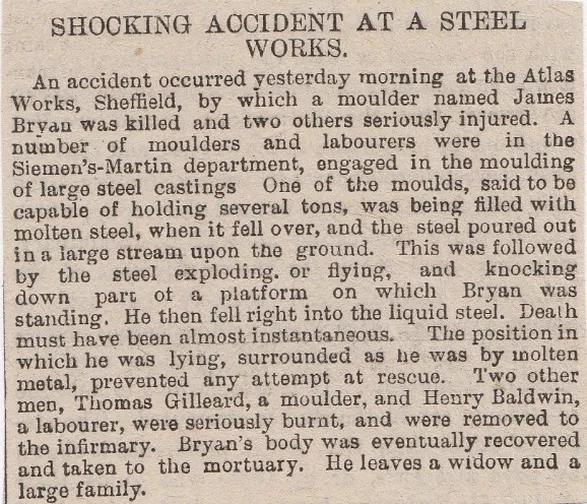
57/ Smithy Bridge Suicide, near Barnsley, July 1884
An inquest on the body of a twenty-one-year-old miner, Robert Palmer of Lundhill near Wombwell, whose body was discovered in the canal near Smithy Bridge late on a Sunday night. The circumstances appear to be that he had a quarrel with his girlfriend and in typical Victorian fashion, over-dramatised the situation. Sarah Wray, a married woman, living at the Old Mill at old bleachworks, claimed that Palmer asked her for a glass of water then sat down and spilt his guts about his girlfriend in Skelmanthorpe. He said he lived at 12, Lundhill Row, and as her father was blown up in the Lundhill explosion, so she made him some dinner and had a cup of tea. He thanked her, then went with her husband to the Tollgate Inn and had four glasses of rum. Next time she heard about him, they were fishing him out of the canal. Police searched his pockets and found; silver watch, that stopped at 8-49, a silver ring, a females portrait, some loose change and a pocketbook. They found a piece of paper in it, with the words- “Hannah Dyson, born 8th April 1864”, and other entries read-
“Skelmanthorpe, July 6th, 1884- Dear Father and mother, I bid you farewell, For with you I can no longer dwell, Having lost the object for which I crave, I commit myself to a watery grave. Goodbye, R.P.”
Well, Robert Palmer, you might as well face it you’re addicted to love- Sorry I couldn’t resist!
58/ Doncaster Street, Sheffield, (Shed Collapsed- Eight Killed) August 1886
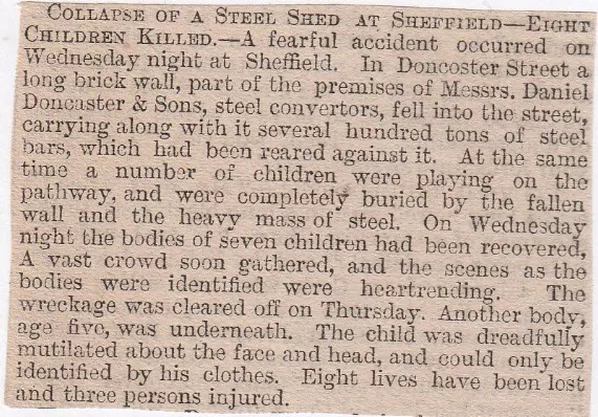
59/ Sheffield, (Insurance Fraud Suicide) September 1879
Edward John Palmer owned a hat business in Snighill, Sheffield. They killed himself in a rather extraordinary manner. It was one Monday night and the shop was ablaze and the entire contents and the stock was a pile of ashes. The insurance agents suspected it of being started deliberately and he became very excited and was “almost beside himself”. They were coming on Saturday to assess the situation in person and Palmer went down into the cellar and hung himself before they came. His wife found his body suspended from the ceiling on a piece of rope.
60/ Silkstone Fatality, near Barnsley, July 1890
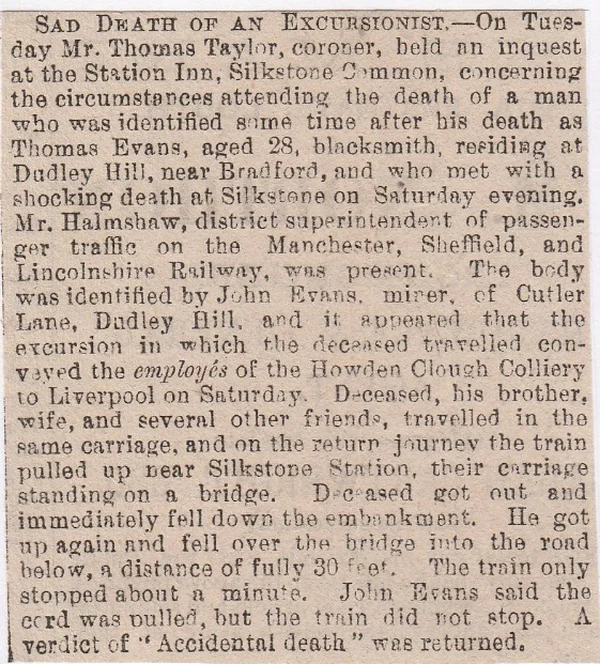
61/ Loxley Valley Double Suicide, Sheffield, May 1881
The dead bodies of a man and woman were discovered in a dam at Loxley Valley, tied together with a piece of cord, by the wrists. They were James Shaw, a married man with three children residing in Rivelin and a young domestic servant named Wagstaffe who worked for a surgeon in Hillsborough. They were an item before Shaw met his present wife, but it appears that they kept seeing each other in secret. They both disappeared on the Wednesday and tongues got wagging and a rumour started up that they’d emigrated to America. They had done nothing of the sort, as they had booked into a room at a public-house on Monday, then spent Tuesday together, then gone to Loxley on Wednesday to kill themselves. There were a couple of letters, a hat, an umbrella and a book and on one of the envelopes Shaw had scribbled: “The end is near- Wagstaffe is the only woman I have ever really loved”.
62/ Corporation Street, Sheffield, (Job Beneath Her) February 1878
A fourteen-year-old lass named Maude Marguerite Orban committed suicide under the strangest of circumstances, thinking that she was too good for working for someone else. She was orphaned as a girl and brought up by her grandparents in Hull, but she was a very good scholar and looked quite a bit older than her fourteen years would suggest. A few months ago the grandparents sent her to a friend in Sheffield so that she might get a job there. They got her a situation but she was totally against working there, saying it was beneath her. On Monday morning she got some “vermin killer” from a chemist and took it. She collapsed on Corporation Street and was taken home in a cab. She told friends that she had swallowed some poison and by eight o’clock that night, she was dead.
63/ Rotherham, (Lark Ends in Death) August 1886
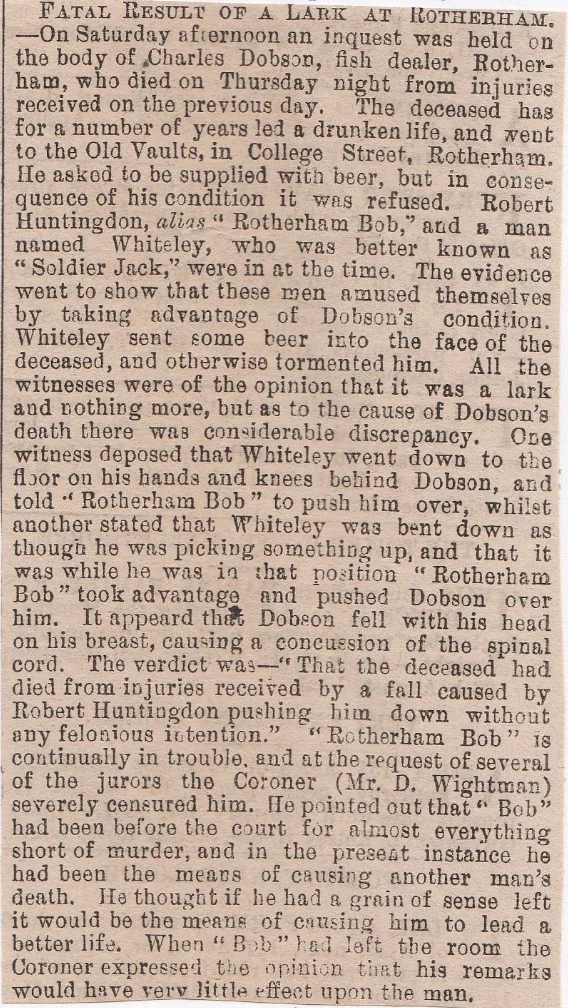
64/ Wesley College Freak Death, Sheffield, March 1854
The chemistry teacher at the Wesley College, Sheffield, named James Haywood died in a freak accident. He was in a laboratory at the college and he was pouring some sulphuric acid into a phial which was in a bottle in a hamper. Somehow the bottle smashed on the floor and he sort of stumbled over and fell on the liquid and glass. A young lad was helping him with the experiment and he was splashed by the acid and ran out of the lab screaming in agony, as the acid started to bubble up on his skin. For a chemistry teacher, Haywood seems to have completely lost the plot and instead of holding his breath and calmly walking out of the room and dousing himself in cold water, he simply lay on the floor inhaling the fumes and being burned by the acid. The other lad was quickly doused in cold water and now only has a few burns that will soon heal. Haywood was taken home, where he died later on that evening.
65/ Doncaster Murder/Suicide? September 1906
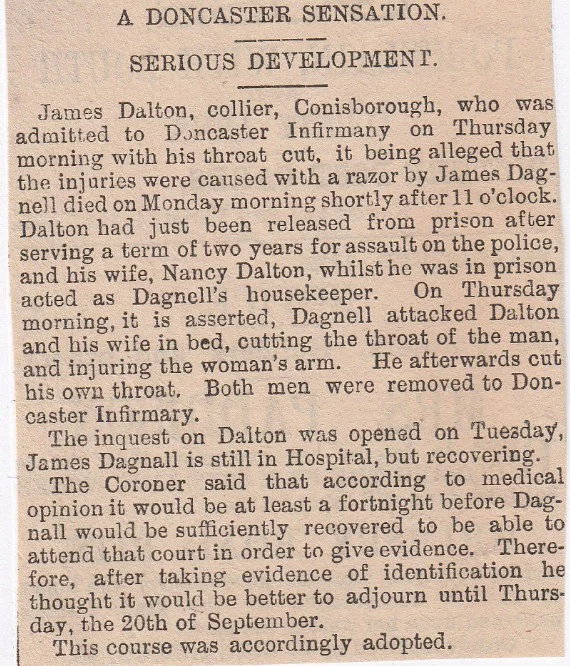
66/ The Holmes Blast Furnaces, Rotherham, (Boy’s Suicide) March 1882
Why a ten-year-old boy would want to kill himself is a difficult question in itself, but the way he did it defies belief as well. Charles Taylor of Harrison Street, The Holmes in Rotherham, threw himself into a “goit”,(water channel) near the Holmes Blast Furnaces. His Mum sent him and his brother on an errand to Masbrough, and nothing happened that would cause such a rash decision, although he lost the cash his Mum had given him. Does that warrant suicide? He thought the repercussions would be so severe that he’d rather drown himself. His brother tried to grab him but he slipped through his grasp and jumped into the goit next to the blast furnaces. It is six feet deep and it was dragged at once, but it took two hours to eventually sift his body out.
67/ Hillsborough Police Station Fire, April 1887
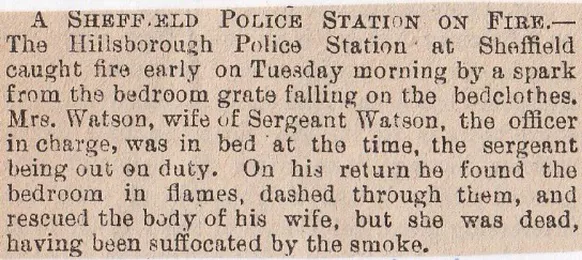
68/ Sheffield Poisoning, January 1865
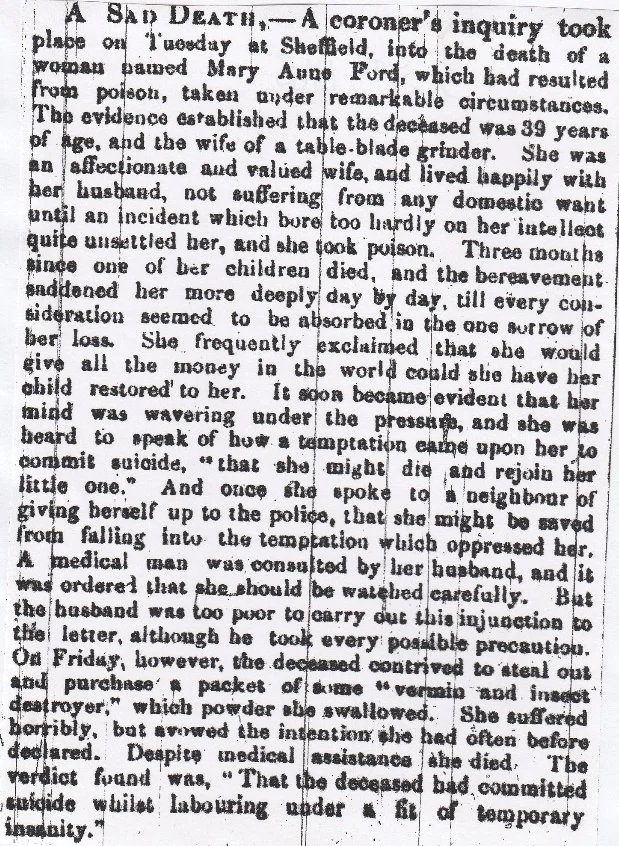
69/ Rotherham, (Boy’s Suicide) January 1872
This one is very similar to the other Rotherham one, a few stories back. Frederick Dolphin aged seven lived with his parents at Ickles Hall, where his Dad was a labourer. His Mum sent him to Rotherham one day for some groceries and a loaf and he took his satchel and tin can to carry the stuff in. He got to Rotherham alright, bought the stuff, but on the journey home, he met a lad named Edward Thane on a bridge which crosses the River Rother near to town centre. He told Thane that he’d lost his satchel and said he’d get a really good hiding when he got back home with no shopping, so he thought it best to drown himself. He climbed a wall, threw his can in, then his cap and cape and then leapt into the murky waters. About twenty yards from the bridge the Rother flows into the River Don and the current is really strong. The body had not been recovered a few days later and it probably has been swept miles beyond the town.
70/ Sheffield Child Starvation, June 1891
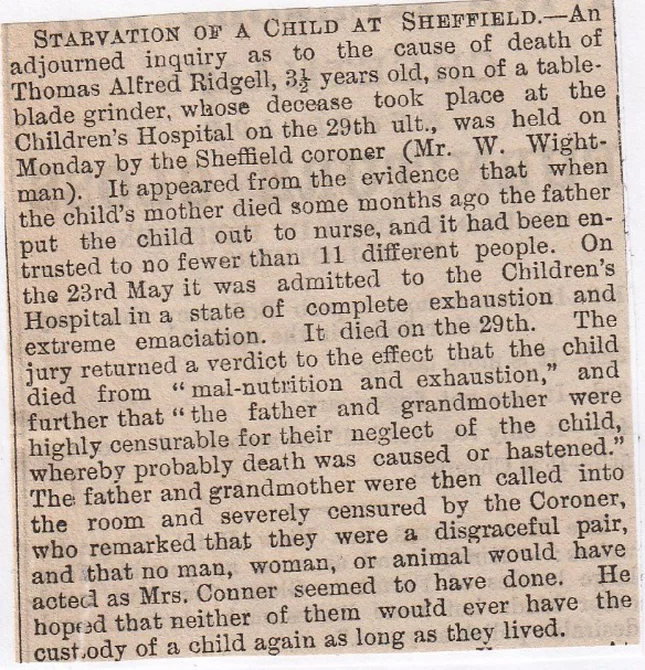
71/ Sheffield Park, (Child Murder Confession) February 1882
This one is an extraordinary confession of a lunatic asylum patient at a Salvation Army meeting in the Mechanics Hall in Nottingham, so should be taken with a pinch of salt! Middle-aged Hannah Froggatt was so affected by the stories she heard, that she piped up and admitted to child murder when she lived in Sheffield. She did it to ease her conscience so she said and was arrested straight away by local police. This is the statement she made at the police station:
“I make this statement of my own free will, because I wish to ease my mind. About the time of the Great Flood at Sheffield, I was living in Sheffield Park with my husband, and I had a nurse child,(foster child?), a girl named Ada North, aged about one year and ten months old, whose mother was Hannah North, a domestic servant, living at Mr White’s Public-house, Basford. I could get no money off the mother for the child’s keep, and it was in my way, as it was ill. After thinking about the matter for a while I decided to kill it. I bought two pennyworth of laudanum, and gave it to the child, a couple of teaspoonfuls at different times, until it was gone, when it died. I called a doctor to see it before it died. He did not say what was the matter with it. I have never told anyone about this until tonight, when I was at a meeting of the Salvation Army at the Mechanics Hall. I told a captain of the Army. I told him because I could not rest. About ten years ago I was sent to Wicklow Lunatic Asylum, and I was there five years before i was discharged.- Signed, Hannah Froggatt”.
When asked what the doctor’s name was she said she had forgotten, but the child was buried in Sheffield she said. Also when asked what part of Sheffield Park she resided in, again she said that she couldn’t remember.
72/ Sheffield Child Murder, August 1890
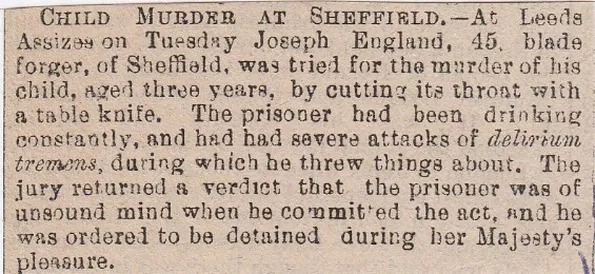
73/ Hadfield Reservoir Child Suicide, August 1884
Henry Mappin aged nine years, residing with his parents at Cobden View Road, Crooks, Sheffield committed suicide one morning. His mother is bed-ridden and when she told him to get ready for school he said it was too late and he didn’t want to go. He walked out the front door, with the mother thinking he had changed his mind. He was spotted by a neighbour, sat on a wall that was next to the Hadfield Reservoir of the Sheffield Water Co., School Lane, opposite the Vicarage as she was dropping her kid off at school. Another neighbour passed him later on and he told her that he was going to drown himself in the Reservoir and to go and tell his sister, Annie. The first neighbour who saw him, was now on her way back after dropping her child off and she mentioned this to the family. A search was made by police and found on the bank of the dam, was his slate, dinner-money and his jacket. They dragged the dam and found his little body after a few minutes of looking. Post-mortem suggests that he hadn’t been dead that long.
74/ Angel Inn, Sheffield, (Fatal Quarrel) August 1892
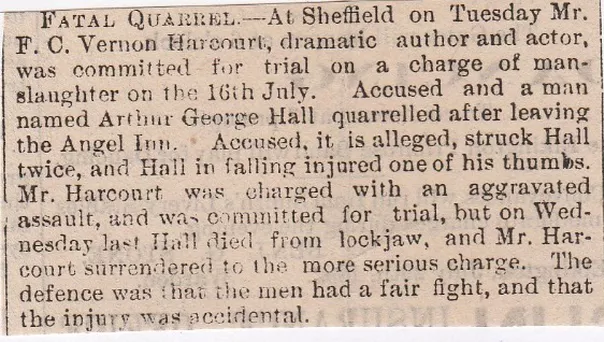
75/ Sheffield, (Child Brutality) October 1906
This is a shocking tale of maltreatment and brutality on a child, so if you’re queasy…go easy. The father’s name was Fred Burrell, who along with his wife were charged with ill-treating his ten-year-old daughter. The N.S.P.C.C. were involved and they adduced that she was the step-mother of the girl, but her brutal treatment had been ongoing for years on end. She was covered in bruises and dozens of sores were found on all parts of her body. Some money went missing and the step-mother wrapped a clothes-line round her neck and told her she would be hanged. She was then smacked and beaten until she confessed to stealing the sixpence, so the punishment was her father’s belt after all that she been through. This was mild in comparison to what was about to happen. The girl had a towel tied around her neck, then she was strung up on the kitchen door. She was there till she lost consciousness and the next thing she knew was the nurse from the society bringing her to, and tending to her wounds. The father’s defence was that he only did it to scare the girl, but he requested a solicitor for his defence against such serious charges.
76/ Woodhouse Wife Murder, Sheffield, August 1889
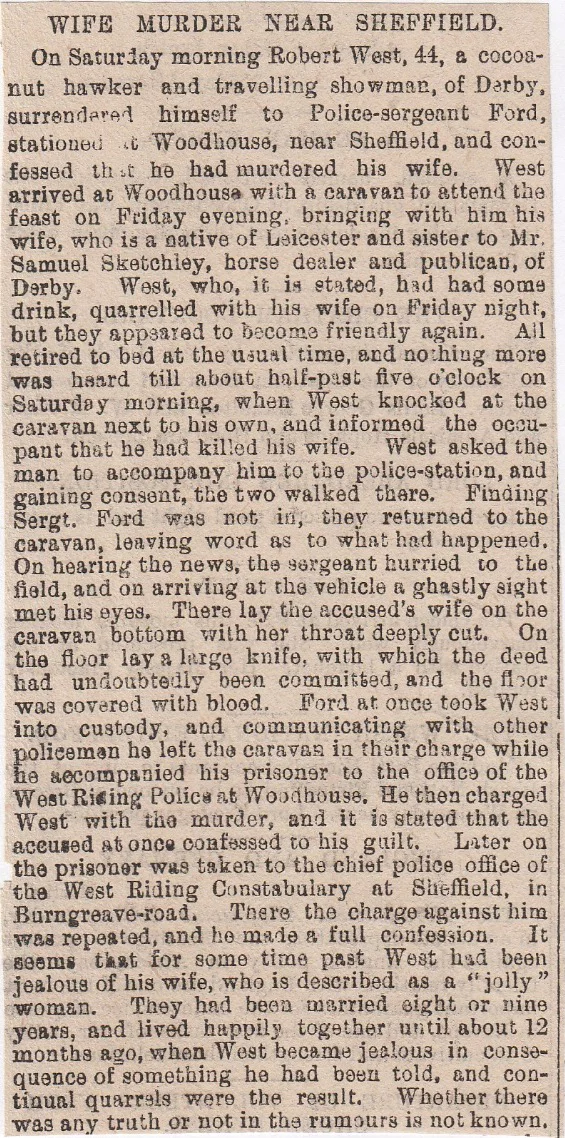

77/ Barnsley Mill Explosion, December 1907
An explosion of massive proportions happened at Worsborough Dale Powder Mills, which is owned by Messrs Kynoch & Company. Most employees had gone home for dinner, so the death toll could have so much worse than it was. It was a quantity of powder that blew up, then that acted as a catalyst for another huge explosion. Robert Craig and Frank Senior were enjoying their packed lunches in a storage house, when they were blown to bits, with parts of Senior’s body being 400 yards from the spot he was having lunch at. There was shattered glass everywhere and houses with smashed windows a couple of miles away. There is massive damage and the works itself is completely destroyed. (Just the two deaths?)
78/ Penistone Railway Accident, January 1st, 1885
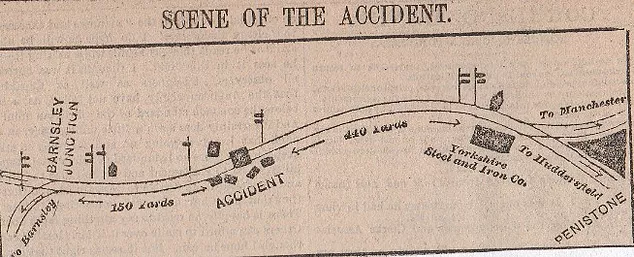



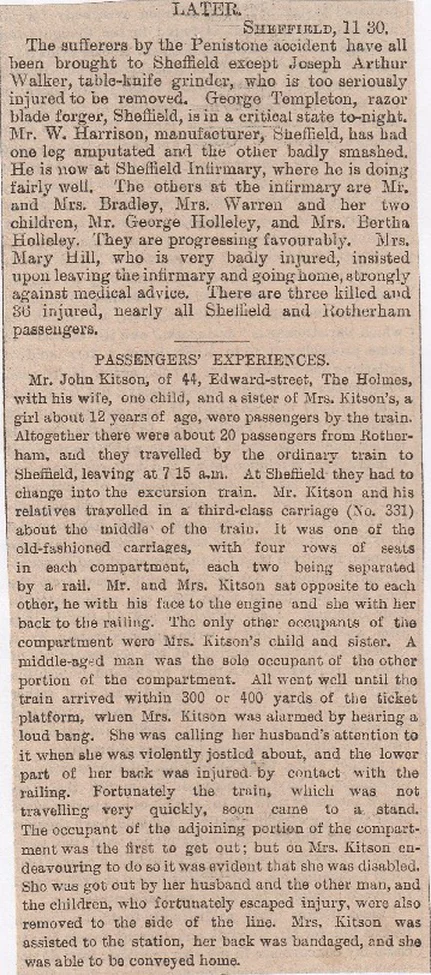
79/ Wombwell Suicide, July 1889
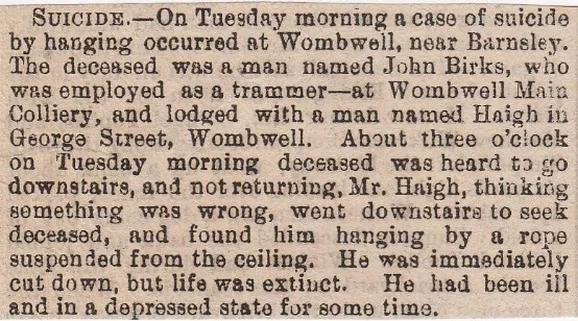
80/ Barnsley, (Housemaid Suicide) December 1882
Thirty-two-year-old Emma Hoyland from Barnsley was for the last fifteen months, the head housemaid at Downham Hall, Clitheroe. Her lifeless corpse was found on the embankment under Victoria Bridge on the outskirts of Barnsley. She had a broken back and arm, plus various cuts and bruises. Hoyland left Downham Hall on Friday or Saturday morning, leaving a note for the under-housemaid on how to pack her clothes and saying that wouldn’t see her ever again, but wishing them all Merry Christmas.
81/ Rotherham, (Attempted Murder/Suicide) July 1895
On Tuesday afternoon a collier named Thomas Lees aged fifty-six of Harthill near Rotherham attempted to murder his wife by striking her with a hatchet and then afterwards committed suicide by cutting his throat with a carving knife. Lees suffered from influenza about six months ago and his health had since been affected. Lately, he had been very depressed.
82/ Sheffield Smallpox Deaths, February 1888
The Registrar General’s report for last week states that smallpox caused thirty-seven deaths in Sheffield, one in Bristol and one in Leeds, but not a single one in London, or in any of the twenty-four other large provincial towns.
83/ Yorkshire Institute for Deaf and Dumb, Doncaster (Singular Death) February 1885
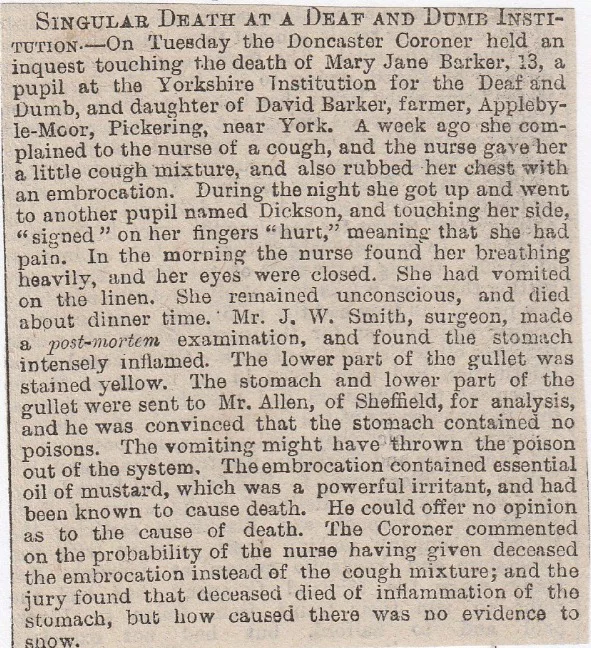
84/ Thorncliffe Colliery Death, Sheffield. August 1870
85/ Sheffield Child Murder, August 1870
At Sheffield, last night, George Hibbershaw, a youth of fifteen years of age, was killed by his step-father. He had given offence to the latter, who is a grinder, by neglecting to deliver a message promptly, and in a sudden fit of anger, he threw a sharp piece of iron at him. The iron struck the boy in the side, and he died three-quarters of an hour afterwards, from the effects of the blow. The father, who is said to have behaved very kindly to the deceased, surrendered voluntarily at the police-station directly after the occurrence.
86/ Barnsley Railway Disaster, December 1870.
87/ Sheffield Shooting Accident, October 1870
A shocking accident occurred at Sheffield on Friday afternoon to Mr Henry Chapman, of that town, who was shooting pigeons with five or six others at the back of the residence of one of the party. Mr Chapman was in the act of firing from the trap, when another from the party, who was standing about thirty or forty yards from Mr Chapman, and from the opposite direction, also fired. Mr Chapman received a large part of the charge in various parts of his face and body. His right eye was completely out, his left eye, it is believed, is also injured, and he lies in a precarious state.

